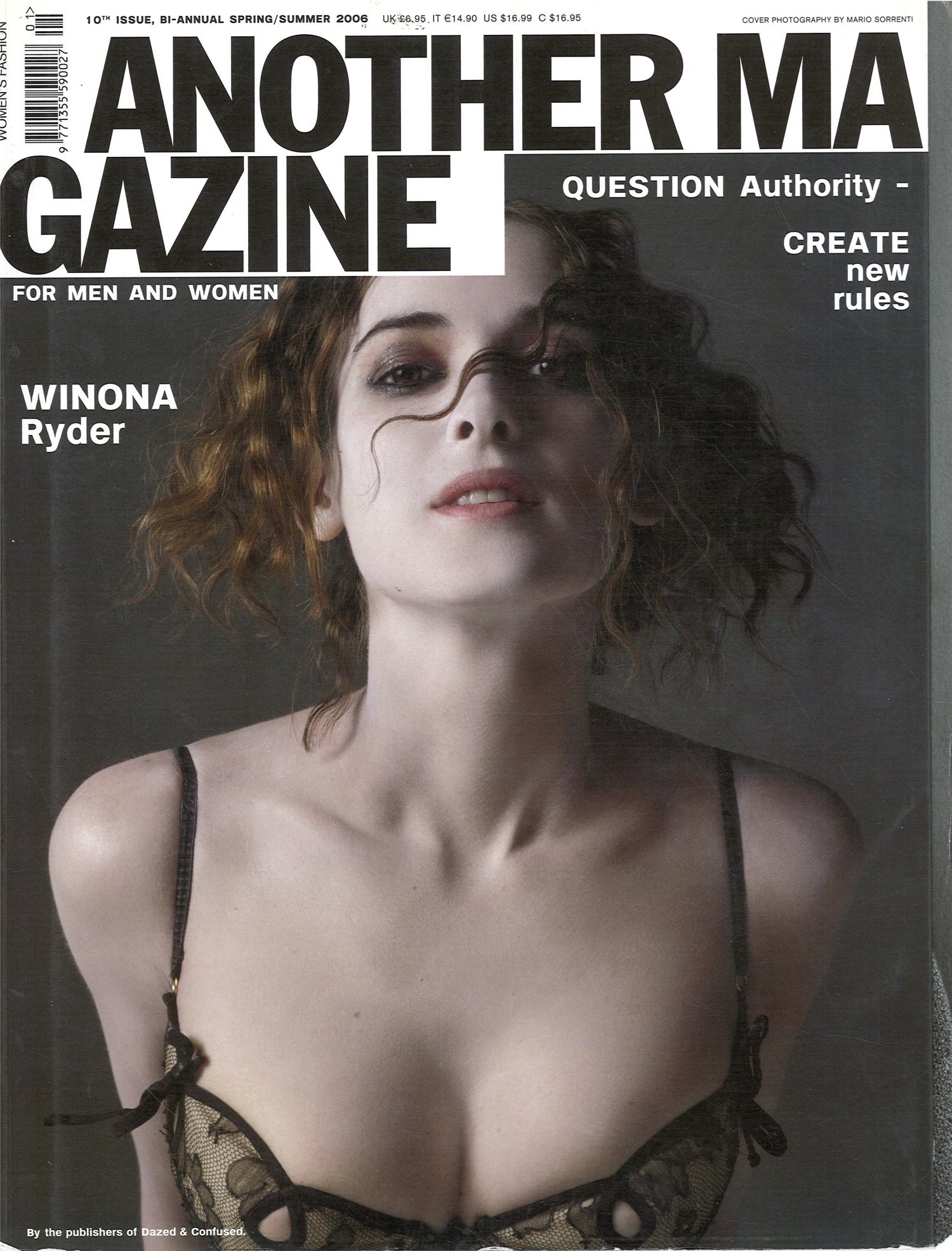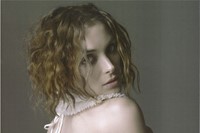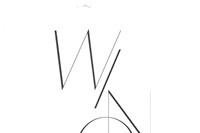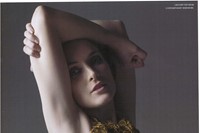In a career that stretches back to her early teens, Winona Ryder has never jumped ship, never made that romantic comedy that would position her as an agent might sell it – in the mainstream. The trajectory was in place when she was 18 after two indie hits, Heathers and Beetlejuice. But if Heathers defined a Swatch generation of Diet Coke heads then Winona, with boyfriend Johnny Depp, was its anti-pin-up. She was raised on old movies and books by parents firmly in the intellectual wing of counterculture. Ask Winona – named after the Minnesota town in which she was born – to pick a favourite performance by an actor and she’ll give you five, from arthouse French to vintage Hollywood. Unpredictable, maybe, but Winona has always been true to the career she wants. She made Heathers against the advice of pretty much everyone, then went on to work with Scorsese and Francis Ford Coppola to name just a couple. She has produced – and in more than just name – a handful of films, using her influence to bring scripts she believes in to the screen, including Girl, Interrupted (1999) and The Day My God Died (2003).
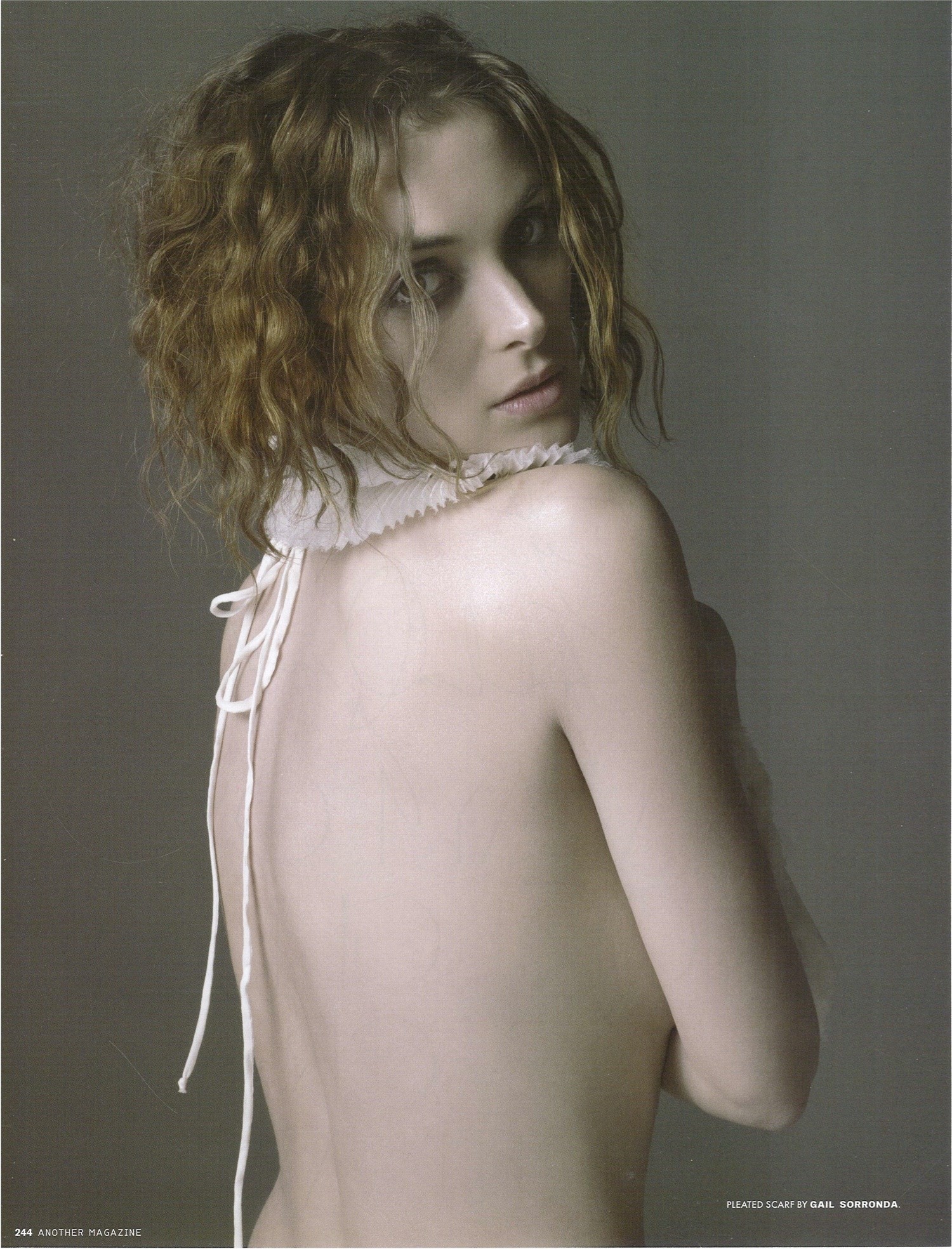
Things got cloudy for a while, and in December 2001, Winona was arrested for shoplifting and possession of drugs without a prescription. “The one good thing to come out of everything that happened is that I realised I wasn’t happy where I was. I wasn’t happy being so famous and being written about all the time. Hollywood people associate movies solely with fame and I didn’t enjoy working in that way anymore. I am so much happier now.” Today, she is back doing what Winona does best, making films that she can throw herself into. First up is The Darwin Awards, a small independent film directed by Finn Taylor, which premiered at Sundance, followed later in the year by Richard Linklater’s A Scanner Darkly.
For our tenth issue, AnOther Magazine invited Winona to talk about ten subjects, a selection of her influences and inspirations. They reveal a natural outrage at injustice, a sensitivity to issues of rebellion, and a worldview, which like Patti Smith’s, has been shaped by the characters who have passed through.
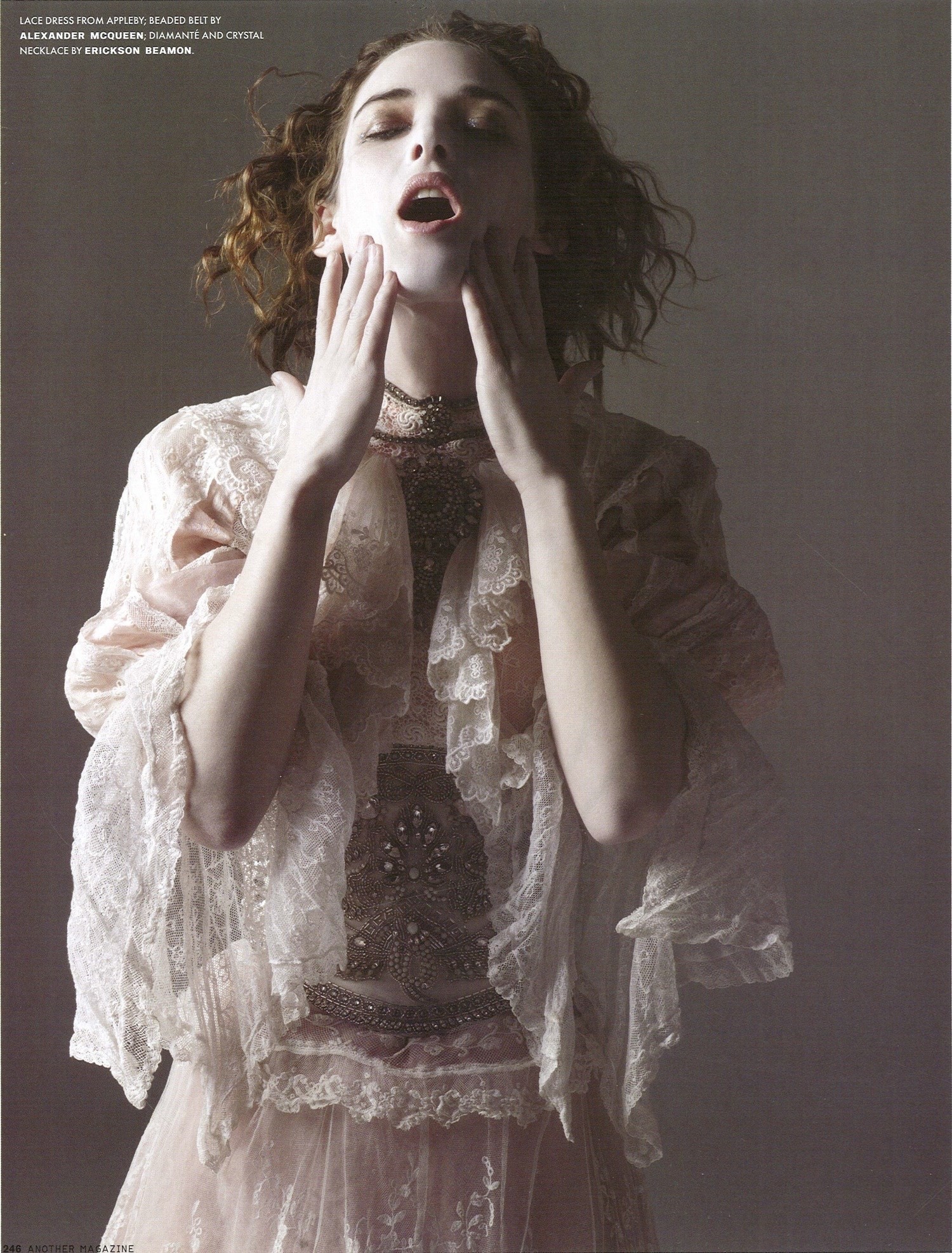

1. Literature
“I discovered Scoundrel Time by Lillian Hellman when I was about 16. It’s one of the most harrowing accounts of the Hollywood blacklist days I have ever read. I used to be good friends with Roddy McDowell and he would have dinner parties where I’d meet people who had been blacklisted during the McCarthy era. Leo Penn (Sean Penn’s father) was one of the first people I talked to. People forgot that actors were imprisoned, and families suffered. There were so many suicides, and the boycott wasn’t fully lifted until the 70s.
“I’d include the script for Heathers in the category of literature. lt said so much about society. There is an assumption when you’re young that things don’t mean as much or aren’t as painful. But first love is the most devastating of all. Society will always look down on teenagers – parents and teachers don’t seem to pay enough attention to kids when they are at their most painful age. Most of the great writers were outcasts, especially the beats. That’s why Lawrence Ferlinghetti is such a hero, because he was the first person to get those artists published.
“The Crucible is one of the best pieces of writing I’ve read. Before I did the film, I appeared in the play, with Arthur Miller in the role of Judge Danforth, which was terrifying. He was a giant man. In one scene, I had to confront him and spit at him. I think he was a great actor as well as a genius writer.”
“There is an assumption when you’re young that things don’t mean as much or aren’t as painful. But first love is the most devastating of all” – Winona Ryder
2. Lyrics
“I always loved the Patti Smith lyric ‘Jesus died for somebody’s sins but not mine’. I got sent home from school for wearing a Patti Smith T-shirt with that line on. I was not raised religiously; my parents always told me to take a piece of whatever religion you like and make it your own. And I’ve always thought that to plant concepts of heaven and hell, sin and burning, into a child’s mind is wrong. The lyric is not a ‘fuck you’ message, it’s about being responsible for your own actions. Like James Baldwin said, ‘We pay for our sins because of the lives we lead.’ lt also makes me think of John Lennon’s quote, ‘Life is what happens when you’re busy making other plans.’”
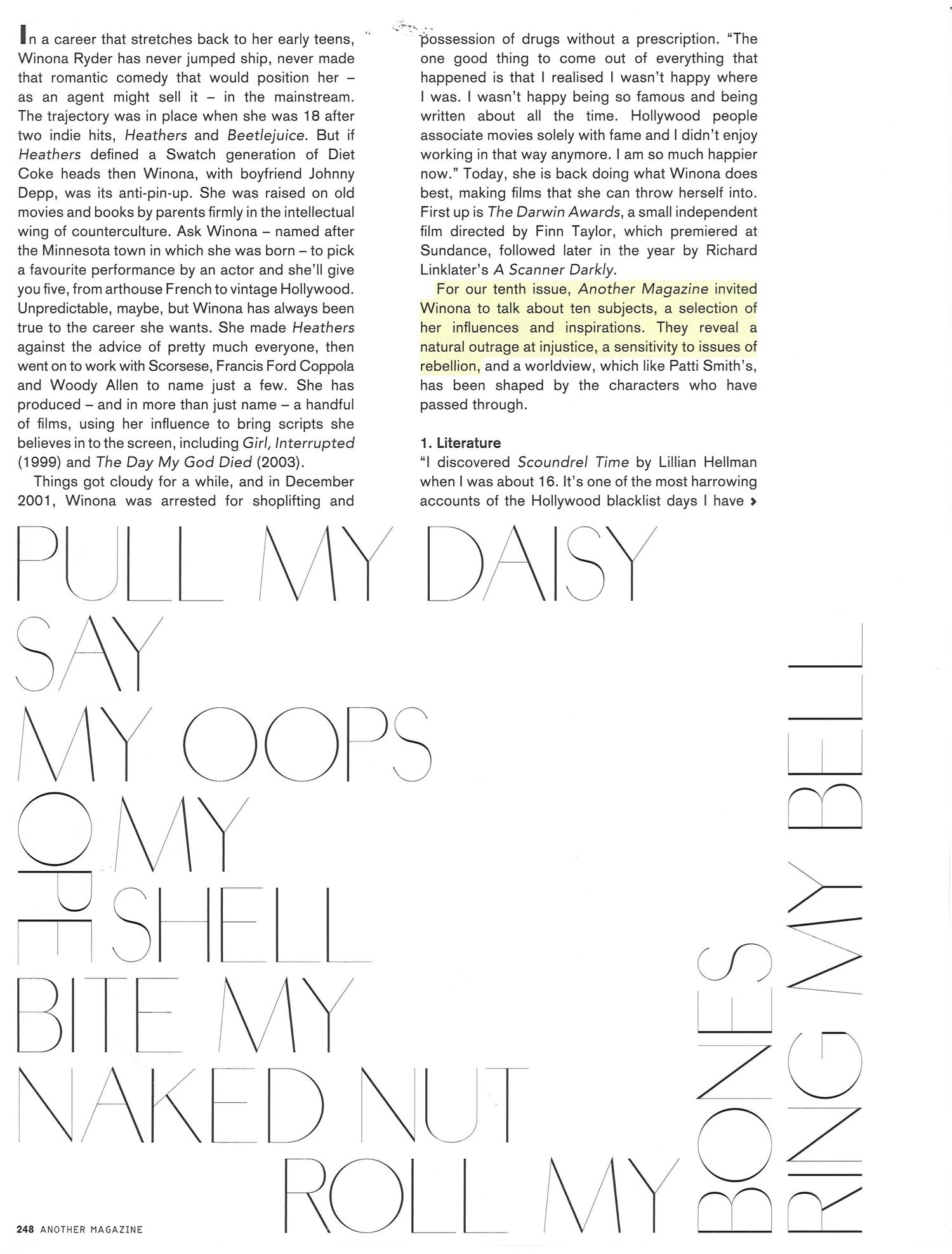

3. Death
“When I heard that John Lennon was shot, it was the first time someone I’d been a fan of had died. To this day, I can’t quite believe it. I was holding my godfather, Timothy Leary when he died. He was smiling and his eyes were locked into the distance. He wasn’t afraid. He considered it to be the ultimate journey. At the time I couldn’t accept it, but he gave me a gift, of not being afraid. When the coroners came they couldn’t get the smile from his face or close his eyes.”
“I was holding my godfather, Timothy Leary when he died. He was smiling and his eyes were locked into the distance. He wasn’t afraid. He considered it to be the ultimate journey” – Winona Ryder
4. Photography
“I own my favourite photograph, Walk to Paradise Garden by W. Eugene Smith. It’s a shot of his two children walking through a cove holding hands. It’s very moving. I also love Robert Frank’s work. I have a series of his, of a couple in Coney Island by a cigarette machine, and then on a bus. They look so comfortable together. I bought the pictures when I was in a relationship, with someone I felt comfortable with. When we split, though it was mutual, I didn’t know why. I tracked down the couple in the photograph and met them. They are still together.”

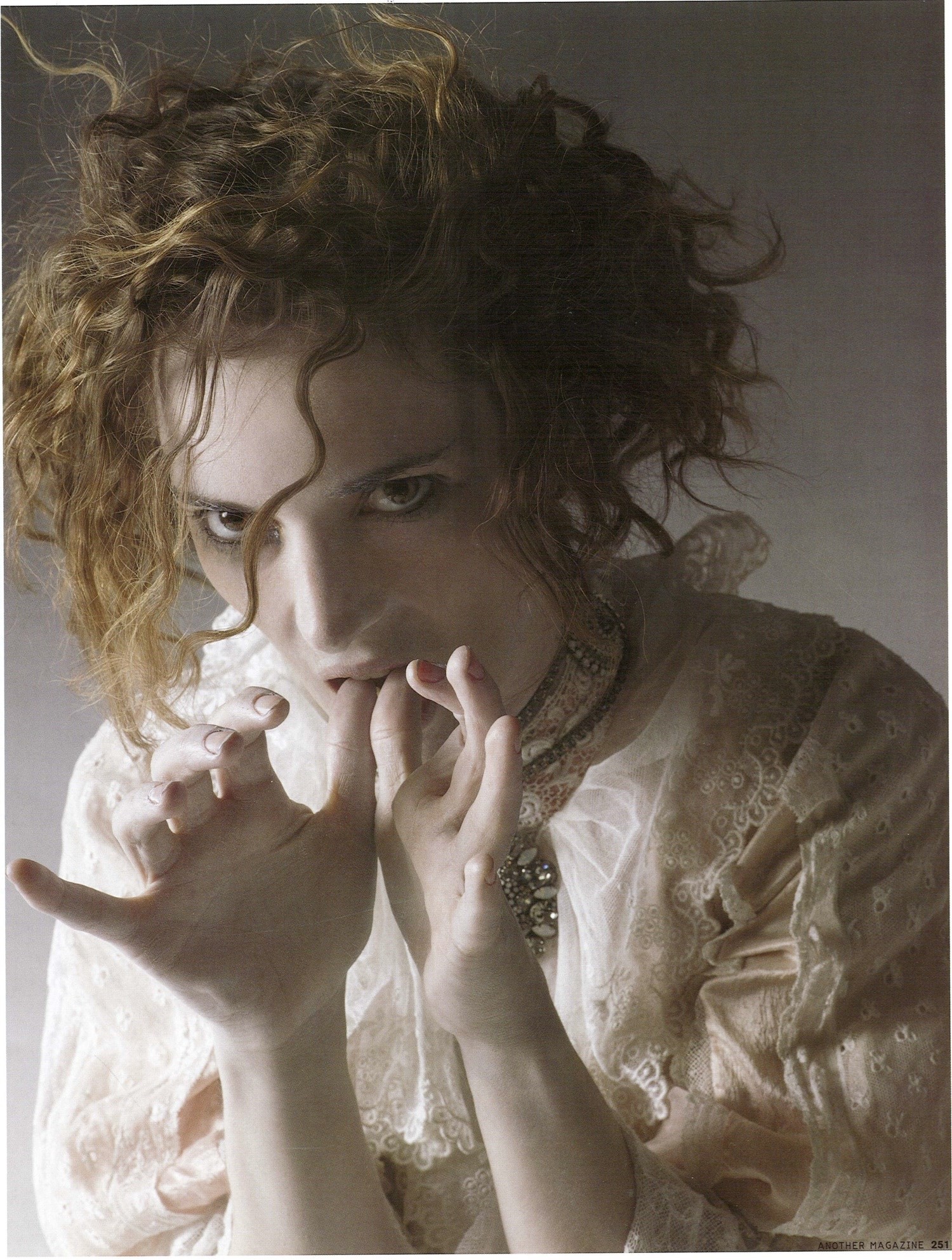
5. A performance
“There’s a French film called Ponette, which stars a little girl, Victoire Thivisol. In the film, her mother dies and the child is taken by her father to stay with her aunt and cousins. The film is about how adults tell children confusing things when their parents die. Like, ‘Pray and you’ll see her in your dreams.’ They mean well and the girl tries everything they tell her. There’s a scene, shot in one take, where she goes into a chapel and prays for her mother to come back. It starts unemotionally and then she begins to cry, and because it’s one long take, it’s amazing to see how she really acts out one emotion. She won best actress at the Venice Film Festival.
“I’m also a huge fan of William Holden, and the choices he made. He took the riskiest parts. Sunset Boulevard for instance, in which he plays a kind of male prostitute. He’s also the anti-hero in The Bridge Over the River Kwai. There is a great scene at the end of that movie, when Alec Guinness is pulling the cord and you see William Holden’s face. I watched it with Scorsese and Jay Cox, and we all agreed that the close-up of William Holden saying ‘kill him’ is one of the best moments in cinema. The pleading in his eyes is mesmerising.
“There are a couple of phrases that my friends and I use. When an actor in a supporting role steals a movie, we say he ‘Cazaled it’, after John Cazale who was in The Deer Hunter and The Godfather. Or when an actress blushes on screen and it’s for real we call it ‘Binoched’, from Juliette Binoche in The Unbearable Lightness of Being, where her cheeks go really red.”
“I’m also a huge fan of William Holden, and the choices he made. He took the riskiest parts” – Winona Ryder
6. A building
“The poetry room above City Lights (Ferlinghetti’s San Francisco bookstore) is a special place for me. The way the light comes in is very beautiful. I used to nap on the comfy chairs there when I was a kid, always knowing that Lawrence was nearby.”
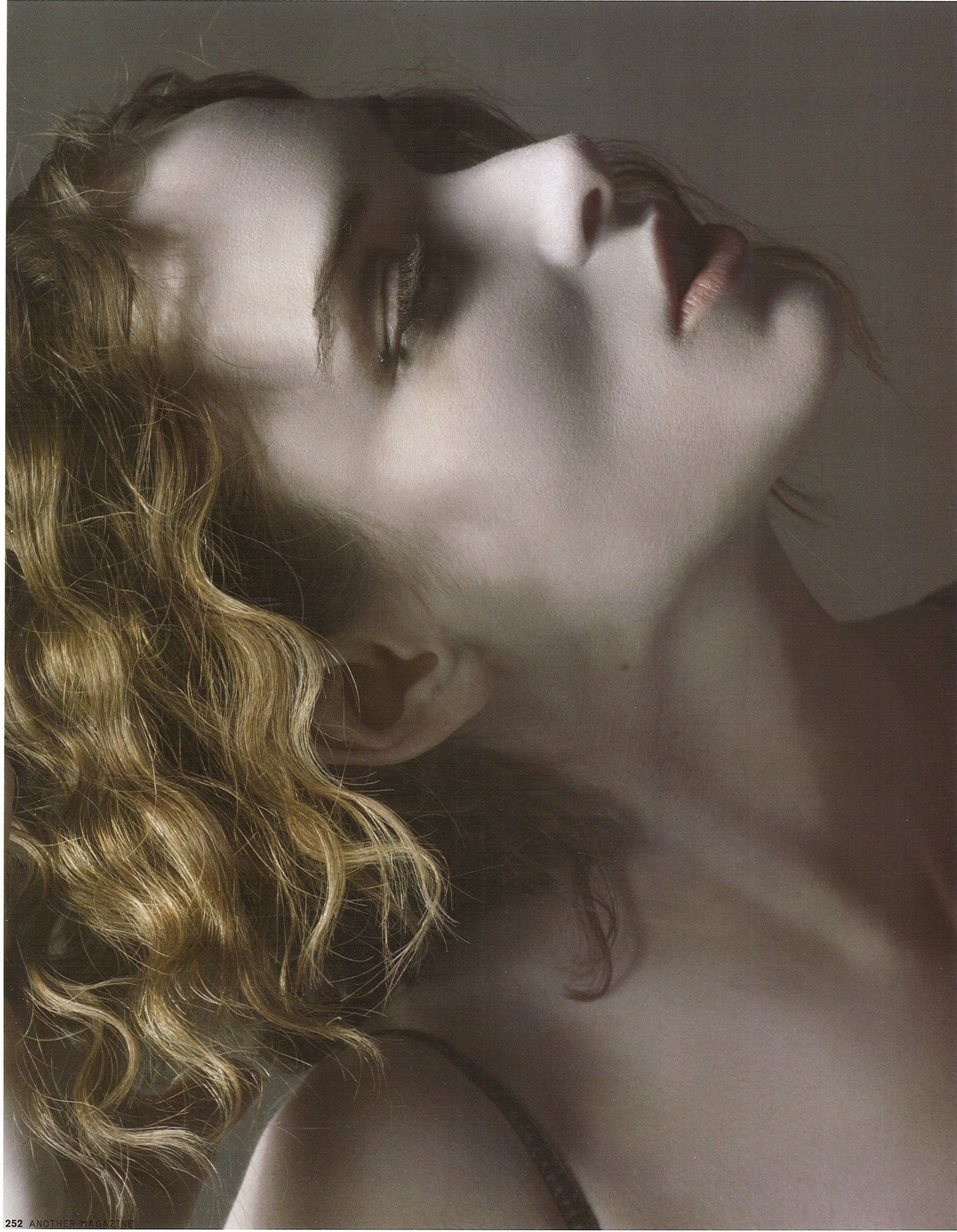
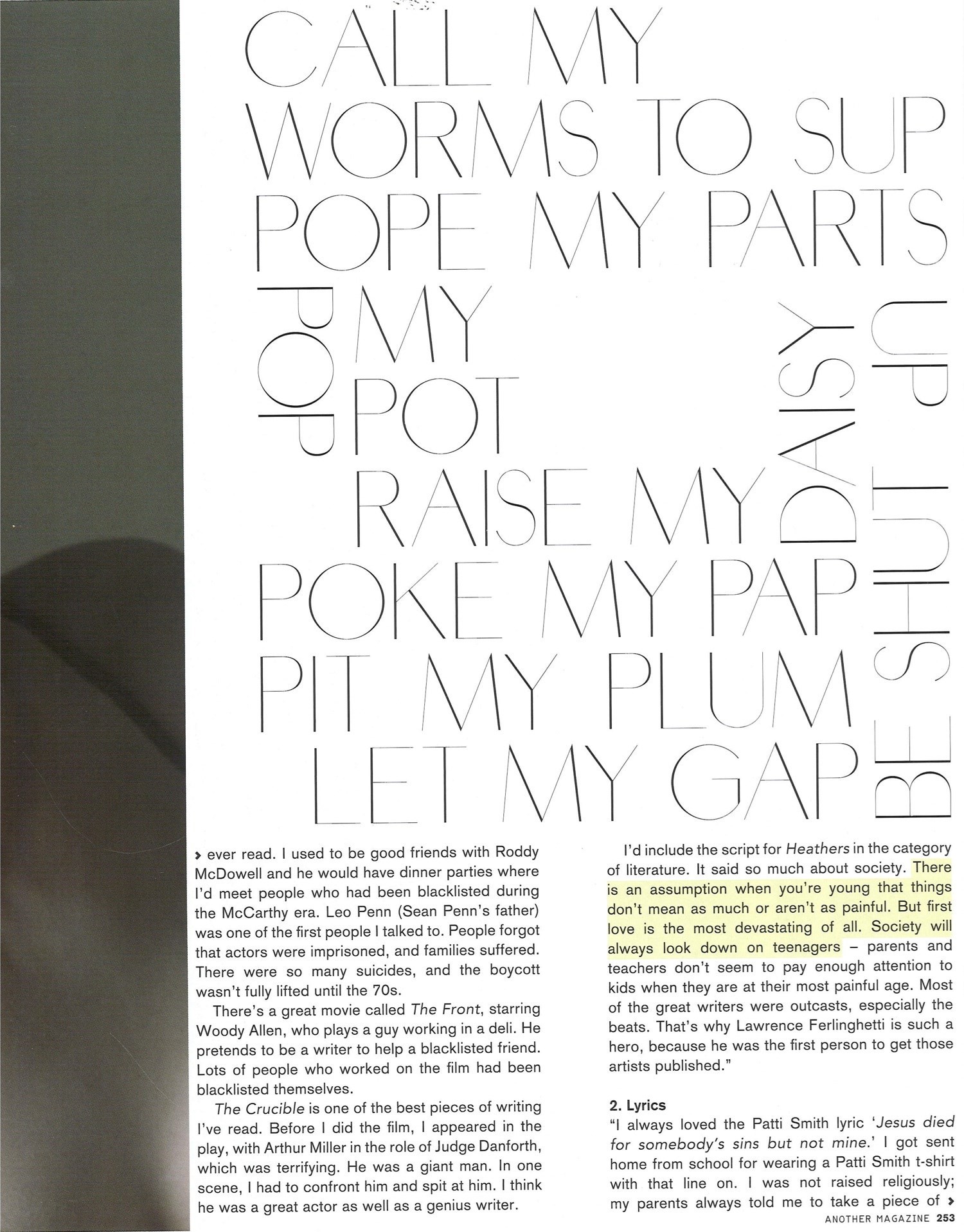
7. A symbol
“I have a tattoo on my arm that I had done after dreaming about the same symbol every night for six months. I finally got up one morning and got the tattoo. I was sure I was going to regret it at some point, but I never have. It’s two Cs interlinking in opposite directions. After I’d had it done I found out it meant compassion, which is great, because that was the most important virtue instilled in me by my parents.”
“My godfather Timothy Leary coined the phrase ‘question authority’, it is one of my favourites. To question our government is the most important thing people can do right now in the US” – Winona Ryder
8. A slogan
“My godfather Timothy Leary coined the phrase ‘question authority’, it is one of my favourites. To question our government is the most important thing people can do right now in the US.”
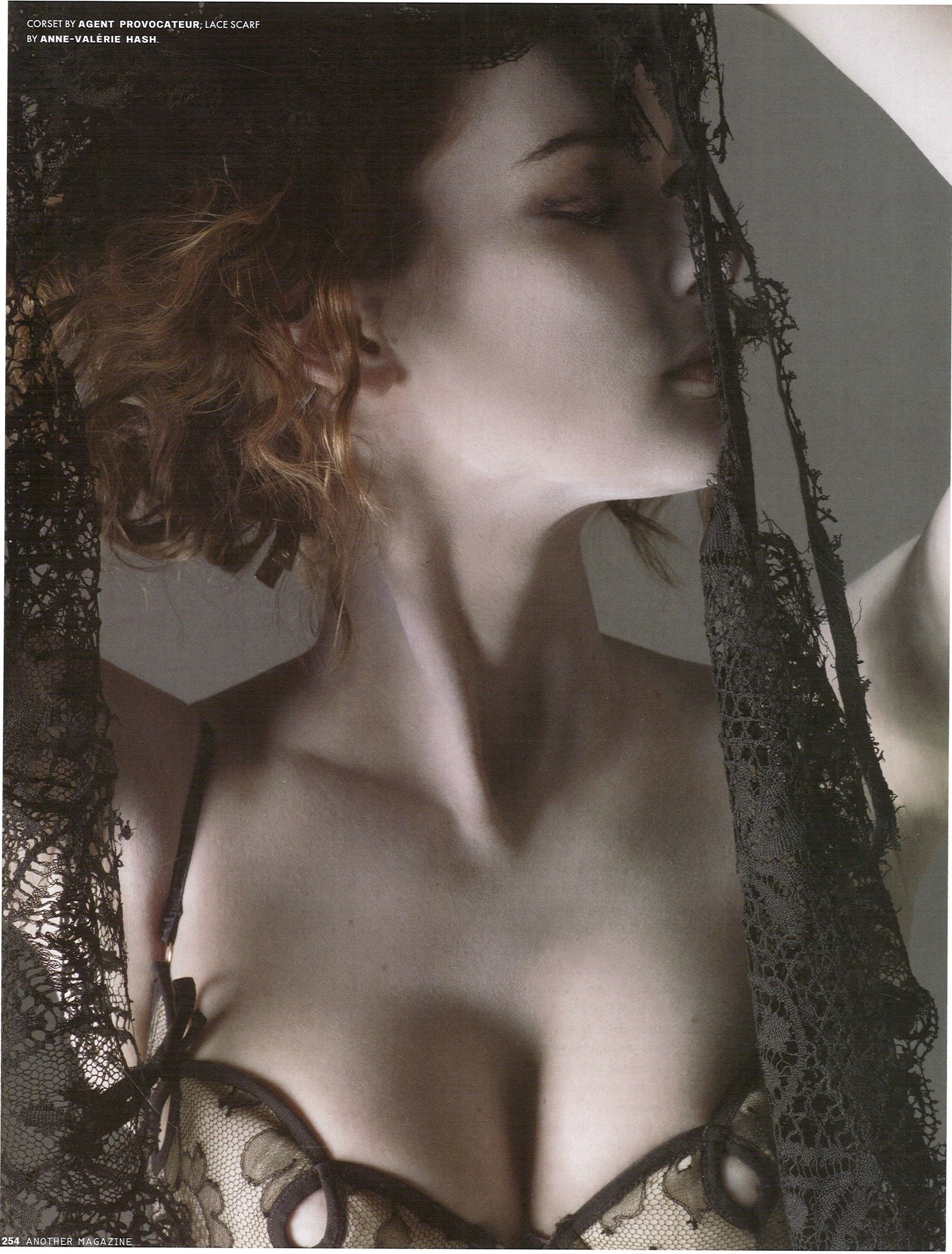
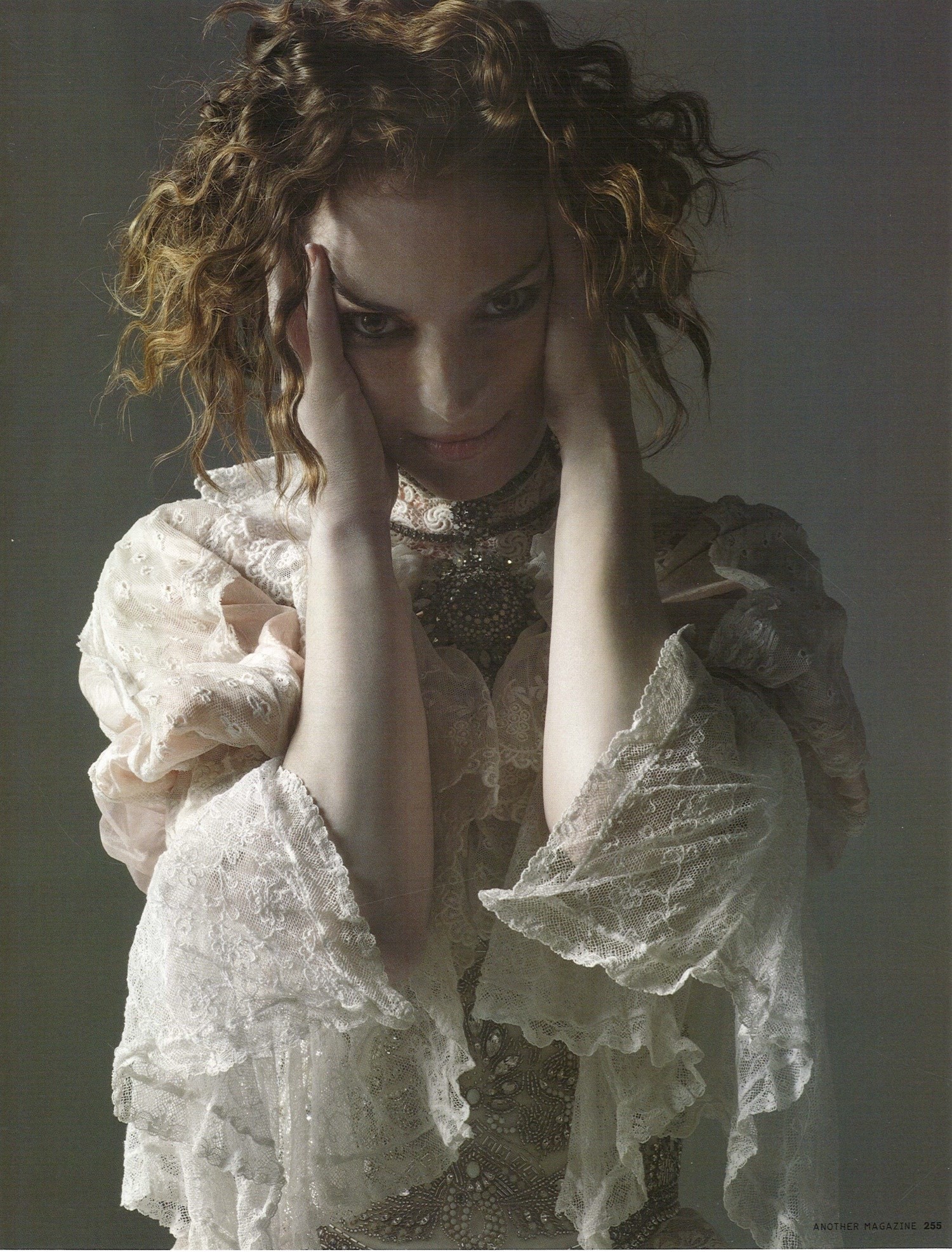
9. A person
“My mother was an activist and is a great mother. She used to say that you could do more good smiling at someone on the street than by putting up a thousand flyers. This idea has its roots in Buddhism, to do everything with love, to cook with love, to have a kindness for strangers. It means so much more to act in peace than to preach it. lt goes back to compassion, which goes back to the tattoo. She was a volunteer hospice worker. My brothers and sister and I used to go with her and help. lt made us a little less afraid, I think, of death.”
“My mother was an activist and is a great mother. She used to say that you could do more good smiling at someone on the street than by putting up a thousand flyers” – Winona Ryder
10. A cause
“I don’t like the word ‘cause’. lt sounds like a bandwagon. I’m on the board of a number of human rights organisations. One is for the West Memphis Three. We have to get these kids out of jail because they are innocent. It’s about justice. The trial happened so fast because the state wanted a result. There were so many inconsistencies in the case; dental impressions didn’t match the three boys in prison. Permission has finally been granted to do a DNA test, which should have been automatic in the first place, but was denied. Now, they are saying that the DNA has been tampered with and is not admissible as evidence. It’s a catch-22. We need funding. There’s been a gross miscarriage of justice, I hope to see them freed soon.”

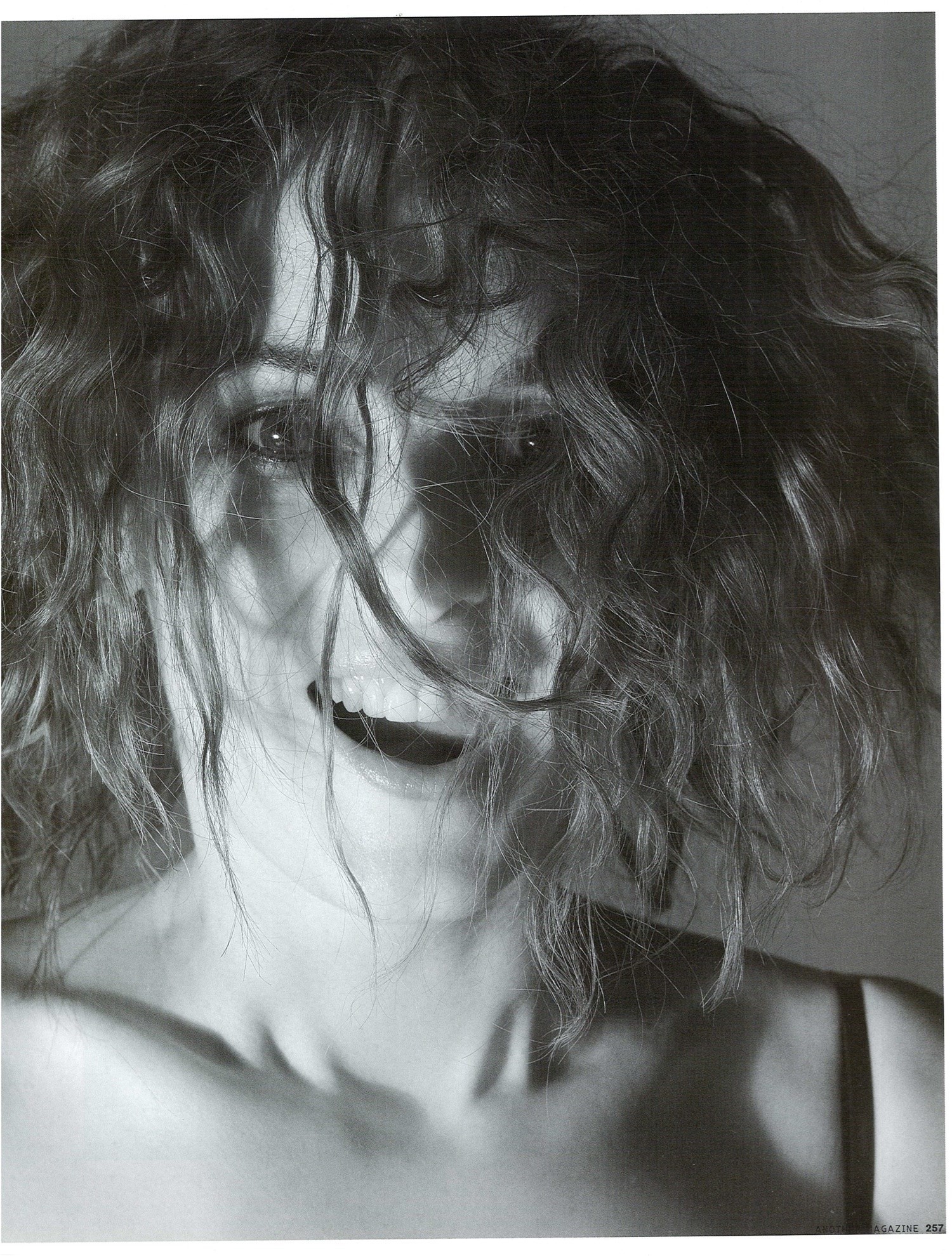
Hair: Recine. Make-Up: Aaron de Mey at Streeters New York. Manicurist: Lisa Jachno for Cloutier using L’Oreal. Photographic Assistants: Lars Beaulieu and Kenny Jossick. Styling Assistants: Mhairi Gibb and Adam Linder. Production: Katie Fash. On-Site Production: Ashley Herb. Digital Technician: Heather Sommerfield. Printing by Pascal Dangin for Box Ltd. Shot at Miauhaus Studios, Los Angeles.
This article originally appeared in the Spring/Summer 2006 issue of AnOther Magazine.
